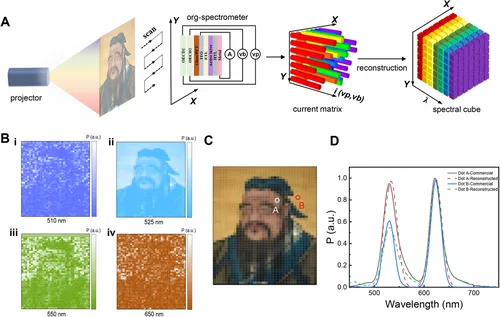Spectrometers are indispensable in the modern information society and play a crucial role in industrial processes, daily life, and scientific research, including environmental monitoring, biomedical diagnostics, and spectral imaging, by revealing light wavelength and intensity information. In particular, the upcoming data/AI-driven era has further amplified the urgent demand for portable/embeddable spectrometers in field applications, such as intelligent consumer electronics, wearable devices, remote industry control/automation, and defense applications, with lab(spectrometer)-on-chip characteristics. Depending on the grating and interferometer, conventional benchtop spectrometers often face inherent limitations regarding bulky size owing to the long optical path, mechanically movable components, and external complex calibrated elements, such as the cosine corrector and integrating sphere, thereby restricting their widespread application in on-chip optoelectronics. The conventional approach based on typical benchtop spectrometers, which minimize the physical optical components or optical path lengths to the submillimeter scale, has inherent adverse effects associated with such scaling. Recently, a newly emerging approach using computational spectral reconstruction has been developed to overcome these scaling issues, with a high resolution in certain cases. These pioneering computational spectrometers, which are based on the principle of wavelength multiplexing and matrix computational algorithms (with necessary statistical/approximation treatment for measuring errors), include diverse architectures such as filter/detector arrays or single-pixel spectral detectors using primarily inorganic quantum dot arrays, gradient single-nanowire alloys, and bandgap engineered 2D materials and van der Waals heterojunctions. The wavelength multiplexing principle lays the foundation for an unknown spectrum dynamic response to achieve a mathematically solvable solution. Ideally, the overall performance, footprint, flexibility, operational spectral range, and adaptability of the spectrometer to different application scenarios and operational stability under various environments, such as different temperatures and humidity, must be considered in practical applications in the information and data-driven age. State-of-the-art computational spectrometers are typically fabricated using intrinsically rigid inorganic nanomaterials via an intricate photo/electron lithography process, posing significant challenges for the anticipated adoption in the increasingly widespread Internet of Things and 5G-related flexible electronics such as wearable and portable devices. Furthermore, the absolute spectral irradiance, which is a critical parameter for any measured spectrum, has not been adequately addressed in these state-of-the-art studies.
Recently, Yongsheng Chen’s group have designed and fabricated a single-pixel org-spectrometer by integrating OECDs and OPDs with an optical cascade architecture using a convenient solution process. In addition to the high performance comparable to that of commercial bulky spectrometers, including a resolution of 0.56 nm, an accuracy of 0.14 nm, a broad detection ranging from 400 to 1000 nm, and significant stability in various conditions, our org-spectrometer successfully realized the vital absolute spectral irradiance measurement under various light intensities from 10−8 to 10−4 W cm−2 nm−1, addressing the critical challenges faced by state-of-the-art computational spectrometers. The high performance of our spectrometer was also demonstrated in spectral imaging for the accurate reconstruction of a real image. Notably, the performance parameters could be tuned by simply replacing the active materials in the device. Moreover, the corresponding FlexOS exhibited almost the same performance as that of its rigid counterpart. In addition to its high mechanical stability, the FlexOS offers unprecedented advantages for wearable and implantable devices. Overall, the strategy using our optical cascade architecture with an integrated and tunable OECD and OPD, together with its high and robust performance, offers vast adaptive design opportunities for flexible and miniaturized spectrometers, rendering them with potential for various civil and military-related optoelectronic applications in the revolutionary data/AI-driven era. Relevant achievements were published in Adv. Mater., 2025. DOI: 10.1002/adma.202502608.
